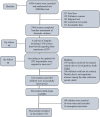Multi-level analysis of the determinants of physical domestic violence against children using longitudinal data from MINIMat mother-child cohort in Bangladesh
- PMID: 38222085
- PMCID: PMC10785797
- DOI: 10.3389/fpubh.2023.1185130
Multi-level analysis of the determinants of physical domestic violence against children using longitudinal data from MINIMat mother-child cohort in Bangladesh
Abstract
Objectives: Despite high levels of physical violence against children (VAC) globally (40-50%), the literature on the determinants of VAC remains inconclusive. Most of the literature on this topic is based on cross-sectional data, and the multi-level nature of the drivers of VAC is widely ignored. This leads to model specification problems and an inability to draw causal inferences. Moreover, despite the higher prevalence of VAC in low-and middle-income countries, studies from high income countries dominate the field. We examined the determinants of physical domestic VAC to address these gaps in the literature.
Methods: Data were collected between 2001 and 2020 from 762 mother-child dyads recruited in the Maternal and Infant Nutrition Interventions in Matlab (MINIMat) study in Bangladesh. We conducted multi-level logistic regression analyses to identify the determinants of physical domestic VAC.
Results: Prevalence of physical domestic violence against girls (69%) and boys (62%) was extremely high. Community-level prevalence of physical domestic VAC increased the likelihood of physical domestic VAC at the individual level across gender (girls - OR-5.66; 95% CI- 3.11-10.32; boys - OR-7.67; CI- 3.95-14.91). While physical domestic violence against mothers was not associated with physical domestic violence against girls, it reduced the likelihood of such violence against boys by 47%. Having 3 or more siblings predicted physical domestic violence against girls (OR-1.97; 95% CI- 1.01-3.81 for 3 siblings; OR-4.58; 95% CI- 2.12-9.90 for 4 or more siblings), but not against boys. While girls in Hindu families were more likely to experience this violence, the boys were not. Mother's education, employment non-governmental organization (NGO) participation and, household wealth did not predict this violence against any gender.
Conclusion: We contend that physical domestic violence against mothers reflects an emphasized patriarchal culture in a family where a boy is less likely to experience physical domestic violence. Social norms and social learning theories explain the greater likelihood of a child experiencing physical domestic violence in a village with a higher level of such violence. We conclude that social norms around physical domestic VAC and patriarchal culture need to be changed to effectively address this violence.
Keywords: gender; multi-level analysis; rural Bangladesh; violence against children; violence against mother.
Copyright © 2023 Naved, Antu, Parvin and Ziaei.
Conflict of interest statement
The authors declare that the research was conducted in the absence of any commercial or financial relationships that could be construed as a potential conflict of interest.
Figures


Similar articles
-
Factors Associated With Domestic Violence Against Women at Different Stages of Life: Findings From a 19-Year Longitudinal Dataset From the MINIMat Trial in Rural Bangladesh (2001-2020).J Interpers Violence. 2023 Nov;38(21-22):11768-11789. doi: 10.1177/08862605231188062. Epub 2023 Jul 25. J Interpers Violence. 2023. PMID: 37489543 Free PMC article.
-
Is domestic violence a risk factor for women's emotional distress in the long run? Analysis of MINIMat longitudinal data from Matlab, Bangladesh.BMJ Glob Health. 2025 Jun 10;10(6):e017209. doi: 10.1136/bmjgh-2024-017209. BMJ Glob Health. 2025. PMID: 40499944 Free PMC article.
-
Domestic Violence Against Women in Urban Slums of Bangladesh: A Cross-Sectional Survey.J Interpers Violence. 2021 May;36(9-10):NP4728-NP4742. doi: 10.1177/0886260518791235. Epub 2018 Aug 24. J Interpers Violence. 2021. PMID: 30141732
-
Bridging the gaps: a global review of intersections of violence against women and violence against children.Glob Health Action. 2016 Jun 20;9:31516. doi: 10.3402/gha.v9.31516. eCollection 2016. Glob Health Action. 2016. PMID: 27329936 Free PMC article. Review.
-
Assessing large-scale violence against children surveys in selected Southeast Asian countries: A scoping review.Child Abuse Negl. 2019 Jul;93:149-161. doi: 10.1016/j.chiabu.2019.05.005. Epub 2019 May 17. Child Abuse Negl. 2019. PMID: 31108405
References
-
- UNICEF . Preventing and responding to violence against children and adolescents theory of change. UNICEF. (2017)
Publication types
MeSH terms
LinkOut - more resources
Full Text Sources

